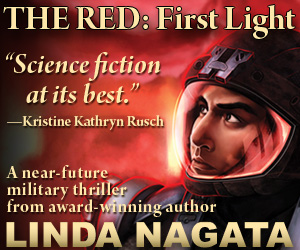How I Self-Published
The Red: First Light
October 9th, 2013
 In my last post, Why I Self-Published The Red: First Light, I talked about why I decided to independently publish my newest science fiction novel. This time I want to talk about the process.
In my last post, Why I Self-Published The Red: First Light, I talked about why I decided to independently publish my newest science fiction novel. This time I want to talk about the process.
In the spring of 2012 I wrote a short story called “Through Your Eyes.†I intended it as a stand-alone piece, but I couldn’t get the protagonist out of my head. I wanted to know what became of him, and The Red: First Light is the result.
From the start I knew the novel would be problematical from a marketing perspective, for the reasons noted in my last post, but I wanted and needed to write this book.
I started working on the novel in early June 2012—a week or so after sending the short story off to market—and finished a very rough draft at the end of September, ironically, about two days before the short story sold to Asimov’s.
After a rewrite, the manuscript went to four beta readers. I incorporated many of their suggestions and then in late December I sent the manuscript to a professional editor. January was spent doing the final rewrite. This is the same process used in traditional publishing except that I paid out-of-pocket for the editor (and it got done much faster).
Copyediting was next. I solicited an estimate from a professional and was told $2000-$3000. Ahem. I couldn’t justify the amount, so I had a fellow member of the writers cooperative Book View Café copyedit the manuscript for me.
To this point, the time I’d invested in The Red: First Light went to writing and revision. Next came the time required to publish. Here’s how that worked out: It took me two or three days to process the copy edits, less than a day to hand-code the ebook, and two to three days to do the interior layout of the print book.
Did I do a professional job? You can see the result for yourself. Go look up the book on Amazon and grab a free ebook sample, or use the “Look Inside the Book†feature to see the layout of the print book. In either case, is the work comparable to that of a traditional book? I like to think it is.
In my experience, cover art is the most challenging part of the publishing process. For The Red: First Light, the cover art was done by my daughter and I’m very pleased with it. The title text was added by me and I wrote the back cover copy.
The ebook was released around March 11, 2013, less than ten months after I started writing it. The print book followed at the beginning of April.
So if I can write the book, hire an editor, get the favor of a copyeditor, coerce an artist, create the ebook, and do the print layout—with the whole process taking less ten months—what benefit is a traditional publisher to me?
Well, discovery, maybe. Readers can’t buy books they’ve never seen from writers they’ve never heard of.
Most readers are turned on to a new book by word of mouth—someone they know or follow online tells them a book is good, so they look for it. Another common method of discovery is bookstore browsing—and here traditional publishers win, at least for now. Because of the way the distribution system works, you will not find The Red:First Light in chain bookstores. Of course, not every traditional book makes it into physical stores either, and those that do tend to stay for a very short time.
Would I have benefitted from discovery in stores? I’m sure I would have made a few more sales, but enough to make it worth giving up my independence? Unlikely, especially given the declining number of bookstores.
In the end, it’s the total revenue that matters. Ten thousand copies sold of an original novel is not going to impress a traditional publisher or lead to meaningfully higher income for me. But working on my own gives me a bigger cut of the list price. So ten thousand copies sold would look very nice to me. (Still working on that number…)
So for me—and every writer is different—traditional publishing of novels does not have much to offer anymore. (Short fiction is a different subject entirely.) If I’m going to gamble my time, my art, my potential, then I want a large share of the potential profits. Indie publishing gives me that. So far, I am not an indie success story, but my work is mine. I control it. I can do what I want with it. I can try new things. I like that. A lot.
Posted on: Wednesday, October 9th, 2013 at 6:00 am
Categories: Publishing.
Tags: The Red: First Light







